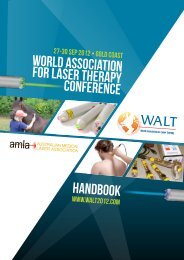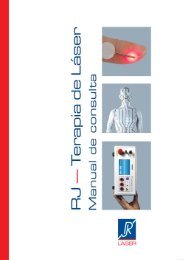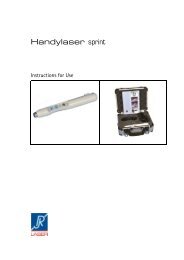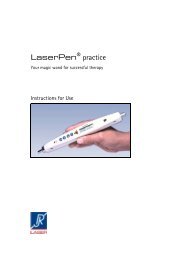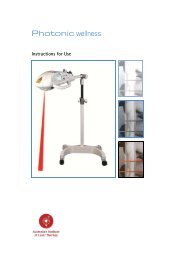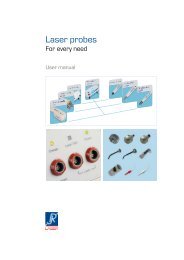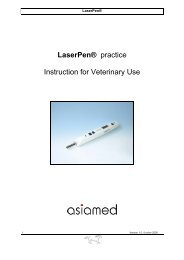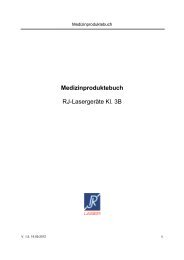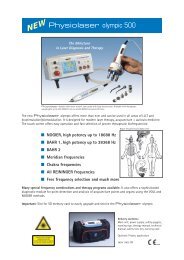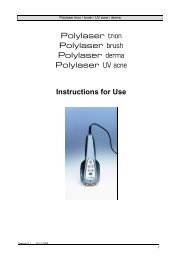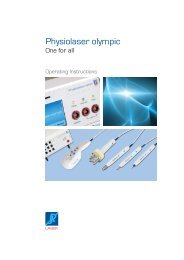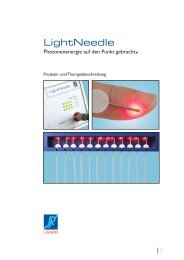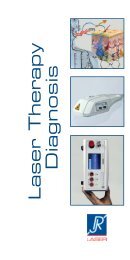LightNeedle - RJ Laser
LightNeedle - RJ Laser
LightNeedle - RJ Laser
You also want an ePaper? Increase the reach of your titles
YUMPU automatically turns print PDFs into web optimized ePapers that Google loves.
MEDICAL ACUPUNCTURE<br />
Volume 20, Number 1, 2008<br />
© Mary Ann Liebert, Inc.<br />
DOI: 10.1089/acu.2007.0606<br />
Original Paper<br />
<strong>Laser</strong>needle Acupuncture: A Critical Review and Recent Results<br />
Detlef Schikora, PhD<br />
ABSTRACT<br />
In the last 5 years, laserneedle acupuncture has become a new category in acupuncture, with its own scientific<br />
basics. It combines the tradition of Chinese acupuncture with the possibilities of modern technology. <strong>Laser</strong>needle<br />
acupuncture is in accordance with the aim of traditional medicine because it uses the most essential and<br />
most natural medium of our existence, the light, to heal illnesses. The painless laserneedle acupuncture is of<br />
proven medical effectiveness and particularly suited for the treatment of children and those patients who regard<br />
the metal needle insertion into the skin as unpleasant. In daily practical use, laserneedle acupuncture can<br />
be performed like any traditional needle acupuncture treatment. The diagnostic criteria of acupoint selection,<br />
the treatment duration, and treatment frequency are identical to the traditional Chinese acupuncture. To perform<br />
successful laserneedle acupuncture treatments, no additional qualification is required. Offering the painless<br />
laserneedle acupuncture to the patient means that the acupuncture needles are substituted and the risks of<br />
the metal needle are eliminated.<br />
Key Words: <strong>Laser</strong>needle, Acupuncture, <strong>Laser</strong><br />
INTRODUCTION<br />
THE BASIC IDEA FOR THE DEVELOPMENT of “laserneedles”<br />
for acupuncture in the Biophotonic Research Group at<br />
Paderborn University (in Germany) originated from an<br />
acupuncture analysis in Europe 10 years ago. At that time,<br />
the first hand-held devices/”laser pens” arrived on the market,<br />
which were recommended as instruments to perform<br />
painless laser acupuncture treatments. It is obvious, however,<br />
that acupuncture treatments using such devices are not in accordance<br />
with the long tradition of Chinese acupuncture<br />
which is based on a simultaneous stimulation of a selected<br />
acupuncture point combination. Hand-held acupuncture laser<br />
devices allow just a serial stimulation of acupuncture points,<br />
i.e., 1 point after the other. The question arises: is it acupuncture<br />
if one sticks a needle in the first acupuncture point, takes<br />
University of Paderborn, Paderborn, Germany.<br />
37<br />
it out after 2 minutes, punctures the second point for 2 minutes,<br />
takes it out again, and stimulates the third point, and so<br />
forth. Every experienced acupuncturist would perhaps answer,<br />
“No, that is not acupuncture. I would never do that.<br />
The needles must remain for at least 20 minutes in the selected<br />
acupuncture points.” That is, the points have to be<br />
stimulated simultaneously. Our analysis came to the same<br />
conclusion; furthermore, we could not find proof in the literature<br />
of a serial point stimulation approach, neither for<br />
metal needles nor for laser pens.<br />
With the development of laserneedles, we have tried to<br />
preserve the methodical rules of the classic Chinese<br />
acupuncture. Several fundamental scientific and medical<br />
problems had to be resolved and investigated:<br />
1) How can visible laser light stimulate acupuncture<br />
points? It is known from daily experience that visible light



